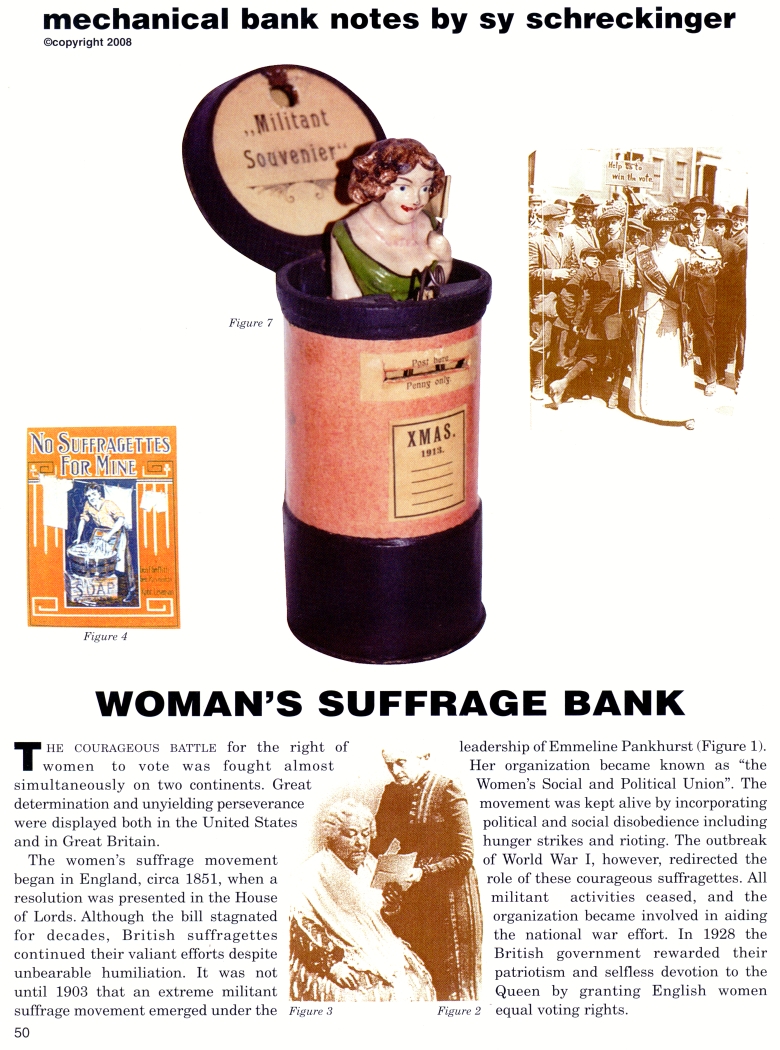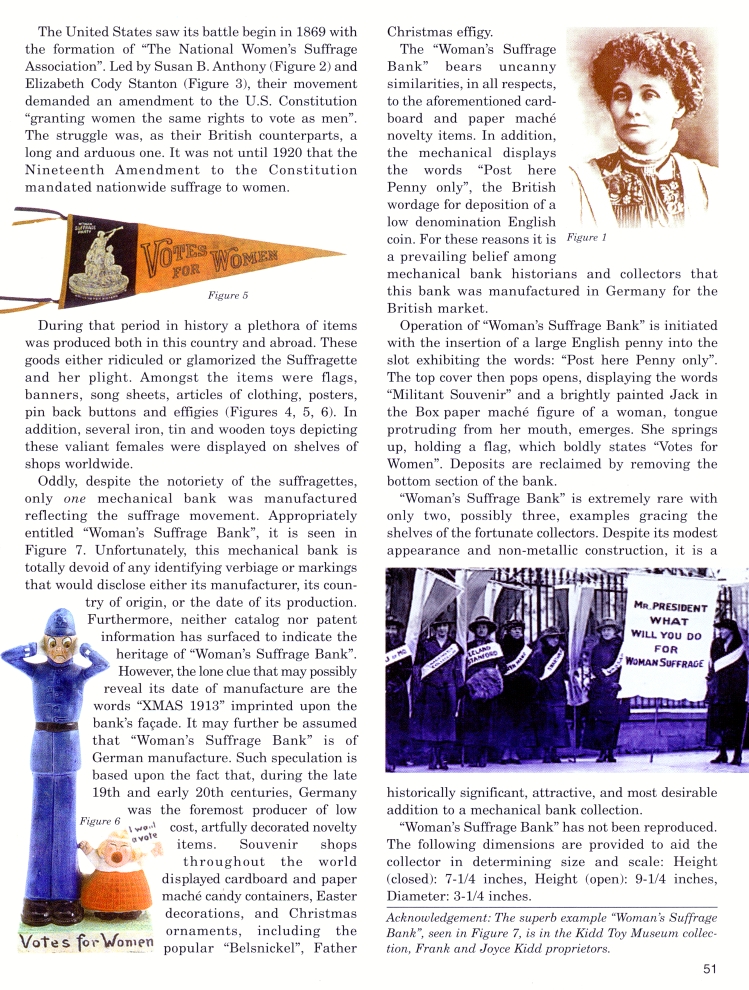|
Woman’s Suffrage Bank
by Sy Schreckinger – ANTIQUE TOY WORLD Magazine – August, 2008
The courageous battle for the right of
leadership of Emmeline Pankhurst (Figure 1). Her organization became known
as "the women to vote was fought almost simultaneously on two continents.
Great determination and unyielding perseverance were displayed both in the
United States and in Great Britain.
The women's suffrage movement began in England, circa 1851, when a
resolution was presented in the House of Lords. Although the bill
stagnated for decades, British suffragettes continued their valiant
efforts despite unbearable humiliation. It was not until 1903 that an
extreme militant suffrage movement emerged under the Women's Social and
Political Union". The movement was kept alive by incorporating political
and social disobedience including hunger strikes and rioting. The outbreak
of World War I, however, redirected the role of these courageous
suffragettes. All militant activities ceased, and the organization became
involved in aiding the national war effort. In 1928 the British government
rewarded their patriotism and selfless devotion to the Queen by granting
English women equal voting rights.
The United States saw its battle begin in 1869 with the formation of
"The National Women's Suffrage Association". Led by Susan B. Anthony
(Figure 2) and Elizabeth Cody Stanton (Figure 3), their movement demanded
an amendment to the U.S. Constitution "granting women the same rights to
vote as men". The struggle was, as their British counterparts, a long and
arduous one. It was not until 1920 that the Nineteenth Amendment to the
Constitution mandated nationwide suffrage to women.
During that period in history a plethora of items was produced both
in this country and abroad. These goods either ridiculed or glamorized the
Suffragette and her plight. Amongst the items were flags, banners, song
sheets, articles of clothing, posters, pin back buttons and effigies
(Figures 4, 5, 6). In addition, several iron, tin and wooden toys
depicting these valiant females were displayed on shelves of shops
worldwide.
Oddly, despite the notoriety of the suffragettes, only one mechanical
bank was manufactured reflecting the suffrage movement. Appropriately
entitled "Woman's Suffrage Bank", it is seen in Figure 7. Unfortunately,
this mechanical bank is totally devoid of any identifying verbiage or
markings that would disclose either its manufacturer, its country of
origin, or the date of its production. Furthermore, neither catalog nor
patent information has surfaced to indicate the heritage of "Woman's
Suffrage Bank". However, the lone clue that may possibly reveal its date
of manufacture are the words "XMAS 1913" imprinted upon the bank's facade.
It may further be assumed that "Woman's Suffrage Bank" is of German
manufacture. Such speculation is based upon the fact that, during the late
19th and early 20th centuries, Germany was the foremost producer of low
cost, artfully decorated novelty items. Souvenir shops throughout the
world displayed cardboard and paper mache candy containers, Easter
decorations, and Christmas ornaments, including the popular "Belsnickel",
Father Christmas effigy.
The "Woman's Suffrage Bank" bears uncanny similarities, in all
respects, to the aforementioned cardboard and paper mache novelty items.
In addition, the mechanical displays the words "Post here Penny only", the
British wordage for deposition of a low denomination English coin. For
these reasons it is a prevailing belief among mechanical bank historians
and collectors that this bank was manufactured in Germany for the British market.
Operation of "Woman's Suffrage Bank" is initiated with the insertion
of a large English penny into the slot exhibiting the words: "Post here
Penny only". The top cover then pops opens, displaying the words "Militant
Souvenir" and a brightly painted Jack in the Box paper mache figure of a
woman, tongue protruding from her mouth, emerges. She springs up, holding
a flag, which boldly states "Votes for Women". Deposits are reclaimed by
removing the bottom section of the bank.
"Woman's Suffrage Bank" is extremely rare with only
two, possibly three, examples gracing the shelves of the fortunate
collectors. Despite its modest appearance and non-metallic construction,
it is a historically significant, attractive, and most desirable addition
to a mechanical bank collection.
"Woman's Suffrage Bank" has not been reproduced. The following
dimensions are provided to aid the collector in determining size and
scale: Height (closed): 7-1/4 inches, Height (open): 9-1/4 inches,
Diameter: 3-1/4 inches.
Acknowledgement: The superb example "Woman's Suffrage Bank", seen in
Figure 7, is in the Kidd Toy Museum collection, Frank and Joyce Kidd
proprietors.
|


